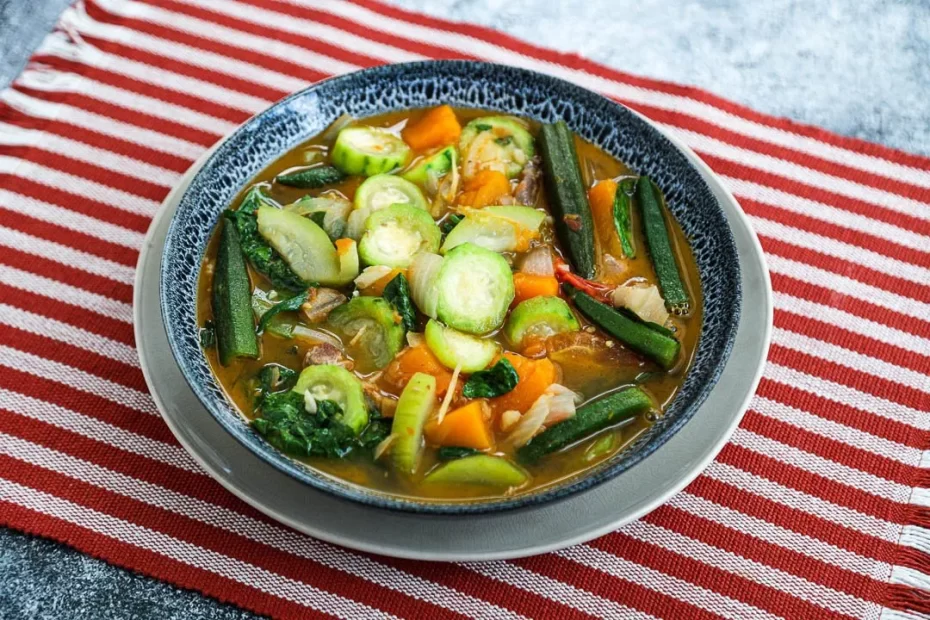Bulanglang, a classic Filipino dish, offers a variety of options: classic, spicy, or vegetarian with a twist, highlighting native vegetables and rich flavors. Enjoy the simplicity and nourishment of this traditional meal with its customizable variations.
Key Takeaways
- Bulanglang is a classic Filipino dish made with native vegetables and a flavorful broth.
- The recipe can be customized with different variations, such as a spicy version or a vegetarian twist.
- Bulanglang highlights the simplicity of ingredients and allows the natural flavors to shine.
- It can be enjoyed as a main dish or a comforting soup, and pairs well with steamed rice.
Classic Bulanglang Recipe
To prepare the Classic Bulanglang Recipe, gather an assortment of native Filipino vegetables and infuse them with a blend of aromatic seasonings to create a flavorful and comforting dish.
Start by heating a pot and sautéing 3 cloves of garlic until fragrant. Then, add in the native vegetables like okra, eggplant, string beans, and ampalaya.
Let them simmer in a broth seasoned with ginger, lemongrass, and tomatoes, allowing the flavors to meld together beautifully.
The key to the classic bulanglang recipe is the simplicity of the ingredients, allowing the natural flavors of the vegetables to shine through.
The dish offers a light and nourishing option, perfect for any meal. Whether enjoyed as a main dish or a soothing soup, the classic bulanglang recipe is a delightful way to savor the rich and diverse flavors of Filipino cuisine.
Spicy Bulanglang Variation
Explore a new level of culinary adventure by infusing your classic bulanglang recipe with an invigorating kick of spice in our Spicy Bulanglang Variation. Elevate the traditional flavors with a tantalizing blend of native vegetables, creating a vibrant and fiery dish that will awaken your taste buds.
Here’s how to prepare this mouthwatering variation:
- Use malunggay leaves, okra, string beans, eggplant, ampalaya, and other native vegetables for an authentic spicy bulanglang variation.
- Enhance the flavor with lemongrass, ginger, garlic, and onion for a robust and aromatic broth.
- Adjust the seasoning with salt and pepper to achieve the desired level of spiciness and flavor.
- Serve the spicy bulanglang hot, garnished with fresh malunggay leaves, and pair it with steamed rice for a wholesome meal.
- Enjoy the spicy bulanglang as a nutrient-rich main dish or as a comforting soup.
Get ready to savor the delightful heat and robust flavors of this Spicy Bulanglang Variation!
Vegetarian Bulanglang With a Twist
With a refreshing twist on the traditional recipe, the Vegetarian Bulanglang incorporates native Filipino vegetables and adds a unique flavor by including lemongrass and small papaya.
You’ll savor the familiar tastes of okra, eggplant, string beans, and ampalaya, enhanced by the zesty notes of lemongrass and the subtle sweetness of small papaya.
The seasoning allows for customization, letting you tailor the taste to your liking for a truly personalized culinary experience.
Whether served hot as a hearty main dish or as a comforting soup, this dish is garnished with fresh malunggay leaves, offering both a burst of flavor and a nourishing meal.
Pair this Vegetarian Bulanglang With a Twist with steamed rice for a complete and fulfilling dining experience.
Frequently Asked Questions
What Does Bulanglang Mean?
Bulanglang means a traditional Filipino vegetable soup with a light, clear broth. It features native veggies like okra, eggplant, and ampalaya, flavored with lemongrass, ginger, and tomatoes. It’s a healthy, customizable dish.
What Local Soup Dish Is Considered Healthy Since It Is Made of Squash Eggplant Okra and Different Kinds of Leafy Vegetables?
You should try bulanglang, a local soup dish filled with squash, eggplant, okra, and leafy vegetables. It’s considered healthy as it’s rich in essential vitamins, minerals, fiber, and antioxidants. Enjoy a flavorful and nutritious meal!
What Are the Different Ways of Cooking Vegetable in the Philippines?
When cooking vegetables in the Philippines, you can boil, steam, sauté, or stew them. These methods help retain the veggies’ natural flavors. Filipino dishes often feature native vegetables like okra, eggplant, ampalaya, and string beans.
Can I Use Native Filipino Vegetables in Pako Fern Salad Recipes?
Yes, you can use native Filipino pako fern in salad recipes. The unique flavor and crunchy texture of native Filipino pako fern add an interesting twist to traditional salad recipes. Incorporating native Filipino pako fern into your salads can elevate the taste and provide added nutritional benefits.
Conclusion
Now that you’ve learned these three amazing bulanglang recipes, it’s time to get cooking!
Gather your native Filipino vegetables, adjust the seasoning to your liking, and enjoy the light and refreshing flavors of this traditional dish.
Whether you prefer it classic, spicy, or with a twist, bulanglang is sure to satisfy your craving for a healthy and delicious meal.
So go ahead, make some bulanglang and treat yourself to a taste of Filipino goodness!
